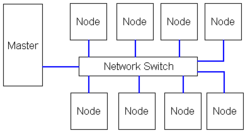Beowulf cluster: Difference between revisions
imported>Aleksander Stos m (WP credit) |
imported>Eric M Gearhart (Removed remaining text from Wikipedia. This article was originally based on the Wikipedia one, it has since been completely rewritten by me) |
||
| Line 16: | Line 16: | ||
| date= Retreived 08-April-2007 | | date= Retreived 08-April-2007 | ||
}}</ref> | }}</ref> | ||
==Beowulf Development== | ==Beowulf Development== | ||
| Line 36: | Line 32: | ||
==Common Beowulf clusters== | ==Common Beowulf clusters== | ||
There is no particular piece of software that defines a cluster as a Beowulf. Commonly used parallel processing libraries include MPI (Message Passing Interface) and PVM (Parallel Virtual Machine). Both of these permit the programmer to divide a task among a group of [[computer network|networked computers]], and recollect the results of processing. It is a common misconception that any software will run faster on a Beowulf. The software must be re-written to take advantage of the cluster, and specifically have multiple non-dependent parallel computations involved in its execution. | There is no particular piece of software that defines a cluster as a Beowulf. Commonly used parallel processing libraries include MPI (Message Passing Interface) and PVM (Parallel Virtual Machine). Both of these permit the programmer to divide a task among a group of [[computer network|networked computers]], and recollect the results of processing. It is a common misconception that any software will run faster on a Beowulf. The software must be re-written to take advantage of the cluster, and specifically have multiple non-dependent parallel computations involved in its execution. | ||
==External links== | |||
The Linux [http://tldp.org/HOWTO/Beowulf-HOWTO.html Beowulf HOWTO], from the Linux documentation project | |||
==References== | ==References== | ||
Revision as of 11:15, 11 April 2007

A Beowulf cluster is a group of personal computers linked together so that they act as one. This is known as parallel computing. This type of cluster is composed of a 'master' (which coordinates the processing power of the cluster) and usually many 'nodes' (computers that actually perform the calculations). The 'master' is typically a server, and "has more horsepower" than the individual nodes. The nodes in the cluster don't have to be identical, although to simplify deployment this is usually the case.
Usually the Beowulf 'nodes' are running Linux,[1] however this is not required, as both Mac OS X and FreeBSD clusters have been created.[2][3]
Beowulf Development
In early 1993, NASA scientists Donald Becker and Thomas Sterling began sketching out the details of what would become a revolutionary way to build a cheap supercomputer: link low-cost desktops together with commodity, off the shelf (COTS) hardware and combine their performance.[4]
By 1994, under the sponsorship of the "High Performance Computing & Communications for Earth & Space Sciences" (HPCC/ESS)[5] project, the Beowulf Parallel Workstation project at NASA's Goddard Space Flight Center had begun.[6] [7]
Popularity in High-Performance Computing
Today Beowulf systems are deployed worldwide as both as "cheap supercomputers" and as more traditional high-performance projects, chiefly in support of number crunching and scientific computing.
It should be noted that more than 50 percent of the machines on the Top 500 List of supercomputers [8] are clusters of this sort.[4]
Common Beowulf clusters
There is no particular piece of software that defines a cluster as a Beowulf. Commonly used parallel processing libraries include MPI (Message Passing Interface) and PVM (Parallel Virtual Machine). Both of these permit the programmer to divide a task among a group of networked computers, and recollect the results of processing. It is a common misconception that any software will run faster on a Beowulf. The software must be re-written to take advantage of the cluster, and specifically have multiple non-dependent parallel computations involved in its execution.
External links
The Linux Beowulf HOWTO, from the Linux documentation project
References
- ↑ "Beowulf Project Overview" (Retreived 08-April-2007).
- ↑ "Mac OS X Beowulf Cluster Deployment Notes" (Retreived 08-April-2007).
- ↑ "A small Beowulf Cluster running FreeBSD" (Retreived 08-April-2007).
- ↑ 4.0 4.1 "The inside story of the Beowulf saga" (Retreived 11-April-2007).
- ↑ "High Performance Computing & Communications for Earth & Space Sciences homepage" (Retreived 11-April-2007).
- ↑ "Donald Becker's Bio at Beowulf.org" (Retreived 11-April-2007).
- ↑ "Beowulf History from beowulf.org" (Retreived 11-April-2007).
- ↑ "TOP500 Supercomputer Sites" (Retreived 11-April-2007).